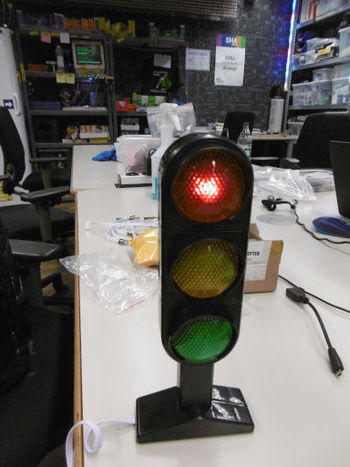BuildStatusTrafficLight
| Project BuildStatusTrafficLight | |
|---|---|

| |
| A traffic light showing CI build status | |
| Status | Completed |
| Contact | bertrik |
| Last Update | 2018-11-20 |
Introduction
The end result of this project is a traffic light that shows the status of a software build.
It can show the following statuses:
- red: build has failed to compile
- yellow: code compiles but a unit test fails
- green: code compiles and all unit tests are successful
- yellow flashing: build status unknown, e.g. still starting up, connection problem, or we receive a status we don't understand
Status
2018-11-18 Soldered new, brighter LEDs into it and connected the ESP8266, no sound yet 2018-11-02 Played with ESP8266 software, particular playing audio using the 1-transistor-circuit 2018-10-30 Received that hardware, opened it up etc.
TODO
- update the arduino code to also allow the status to be set over serial: I plan to use my basic "command interpreter" that I've also used in previous projects
- write a simple python script that polls the build server and updates the traffic light over serial
- figure out which URL I need to poll to achieve this
Hardware
I use an ESP8266 (Wemos D1 mini) along with a modified toy traffic light (see below).
I'm using this toy traffic light, modified for use with the ESP8266. It lights the lanterns in order, speaking some Chinese for each lantern. The lanterns are basically white LEDs behind a colored piece of transparent plastic.
I replaced the white LEDs with high-brightness coloured ones (red, orange, green). The ESP8266 can officially source about 12 mA and sink about 20 mA of current, I'm using a single 150 ohm resistor in the common ground wire of the LEDs. It would be better to actually put it in a common Vcc wire, because the ESP8266 can more easily sink current than it can source it.
I haven't put in the sound circuit yet, that would be on the RX pin along with usage of the ESP8266Audio library in software and the 1-transistor driving circuit.
Software
Source code can be found on github.
It is written in C/C++ for Arduino for quick and easy development using existing libraries, like WifiManager, PubSubClient.
The plan is to simply listen to an MQTT stream. To keep things secure and secret as much as possible, I plan to use an encrypted link to the MQTT server along with a username/password.
External links
- Jenkins traffic light plugin seems to have the wrong kind of interface, designed to directly drive a bunch of wireless 230V sockets instead of just sending the information like I need
- Signalling Your Jenkins Build Status with a Mini USB Traffic Light